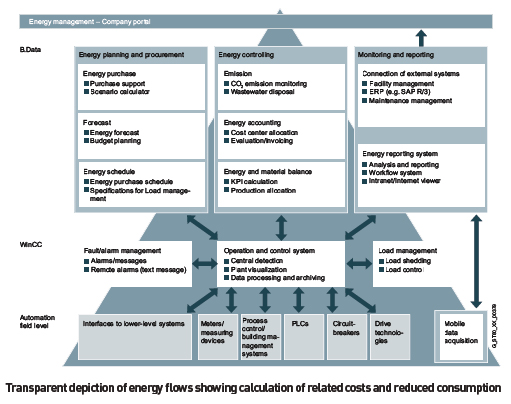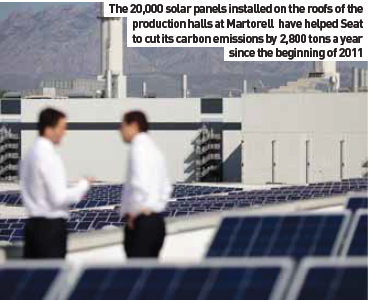Sustainable production through energy savings
With over 80 million vehicles sold in 2011, global energy demand has never been higher. AMS reports on how Seat Martorell and Daimler have implemented some advanced efficiency solutions with help from Siemens.
Continuing growth in the BRIC markets, particularly in China and India, is set to continue to drive up the global demand for energy even further. At the same time, resources are growing more expensive around the world. This makes the issue of energy efficiency one of the biggest challenges faced by automakers and their suppliers. Compounding the cost pressures are ever-more stringent statutory requirements governing energyefficient production and reduced carbon emissions. Some carmakers have achieved the ISO 50001 standard for energy management systems [published in 2011]—designed to help drive down energy costs, greenhouse gases and other global environmental impacts—but many other OEMs still need help to meet this standard.

As an example of how manufacturing suppliers are responding to this global challenge, at this year’s Hannover Messe, Siemens continued its focus on “connecting productivity and efficiency”.
The company showcased many imaginative ways to help its customers achieve their economic and ecological targets. “Energy consumption is a significant environmental and cost factor in the world of auto production”, explains Engelbert Lang, head of the professional services energy management department at Siemens Industry Automation, adding: “The sparing use of energy is becoming a decisive factor for survival in the competitive global marketplace.”
Energy saving - a vital performance indicator at Seat
As an example of an automaker working towards greater sustainability, Volkswagen aims to make its production 25% more environmentally friendly by 2018, and is looking to achieve this specifically by cutting energy consumption, waste, airborne emissions, water consumption and carbon emissions. Volkswagen subsidiary Seat, in Martorell, Spain is demonstrating the implementation of this strategy. An approximately 13,000-strong workforce at the plant produces over 300,000 vehicles every year, and won production of the new Audi Q3 last year. A key aspect underlying this decision was the success achieved by the factory in terms of improved energy efficiency.
According to one plant manager, the importance of energy expended in the production of each vehicle is now seen on par with the issue of man hours per unit—the area of overriding concern just a few years ago. In practice, this means in a comparison of key indicators, the production process will be assessed not only for economic success but also for its ability to drive down energy consumption during production by 2% per vehicle year over year.

Getting the balance right
To identify precisely where energy is required, Seat opted to implement an energy management system from Siemens. Energy management software B.Data permits the current status of all energy and material flows required in production and in ancillary processes—such as water, electricity, pressure or steam—to be continuously and reliably logged. With the aid of the Siemens software, users can draw up detailed reports tailored to their specific requirements. Energy consumption can also be assigned to the respective cost units on a usage-related basis, even where complex calculation models are used. An application which faciltates analysis to this degree of detail is a significant benefit when it comes to the sustainable implementation of energy targets.
The next step is for B.Data to supply a solid, viable decision-making platform on the basis of key performance indicators (KPIs) for the adoption of energy optimisation measures and the necessary investment. “Using the energy management system certainly pays off in financial terms”, Engelbert Lang of Siemens Industry explains. “The analysis often provides pointers for optimising the system which can be implemented using only the simplest of measures, such as detecting leaks or ensuring more even load distribution. Without the need for any additional investment, this type of measure can result in energy cost savings of between five and 10 percent.” This effect can be significantly increased by the use of modern drive and automation technology. The team at Martorell was also able to improve the energy balance in the paint shop with the aid of Siemens software. Painting is the most energy-intensive process of all in automotive production, accounting for around 45% of total consumption. The potential for savings is equally enormous. To drive down consumption in its paint booths, Seat worked with Siemens to retrofit the electrical drives of the ventilators by the addition of modern Sinamics frequency converters with servo drive. The converters continuously adjust the current consumption of electric motors operating at part-load on a need-driven basis. This efficient and flexible retrofit solution opens up savings potential of up to 60% compared to conventional mechanical controls. In addition, using B.Data, these savings can be documented and verified. This is a key aspect for compliance with internal controlling requirements set out by energy management standard ISO 50001. Special converters are also at work in the automatic high-bay warehouse used to store engines at Seat. These converters feed energy, generated by the braking resistance in the lifting drives of the rack handling system, back into the grid; energy that is otherwise lost. Compared to the use of standard converters, this cuts the amount of power required to operate the lifting drives by more than half.
AMS talked to Engelbert Lang, head of the professional services energy management department at Siemens Industry Automation, about key levers for improving energy efficiency in the field of auto production.
AMS: What role does energy efficiency play for automakers and their suppliers today? Engelbert Lang: It’s an issue of decisive importance. The efficient use of energy will be the deciding factor determining a manufacturer’s competitive standing in the future. Energy efficiency today [is] a major cost issue for the automotive industry. The cost of energy is set to soar, as is the demand for energy. What we need here are smart concepts to help us optimise the flow of energy and save resources in existing plants. Where new greenfield plants are in the planning stage, energysaving alternatives to existing concepts must be considered right from the start. Automakers are also faced with an increasing flood of national and international environmental regulations and standards such as the new ISO 50001 Energy Management Standard.
AMS: How does drive and automation technology contribute towards energy-optimised production? EL: We help our customers achieve their environmental targets by offering a comprehensive environmental portfolio, which includes modern, energy-efficient drive and automation technology. We take an integral approach that concentrates not only on individual components but also on the interplay between them and their concrete implementation in practice. We describe our approach to the subject of optimisation in three phases; identification, evaluation, and implementation. Once the energy requirement of a specific sub-process has been determined and set out...we assess the concrete potential for savings on this basis. We subsequently offer support to the customer in implementing energyefficient measures. In the future, energy will increasingly be factored in as a standard procedure; already today, many of our products are made available complete with integrated energy values.
AMS: How great is the potential for savings?
EL: Worldwide there are around 20 million industrial motors in operation. They account for around one third of the total electrical energy used throughout industry. This is why we attach particular importance to drive technology. In most cases, the greatest savings are achieved with a whole raft of intelligently interlinked measures. We optimise individual applications but also whole plants, keeping a close eye not only on main processes but also ancillary processes such as heating, ventilation or lighting. By deploying modern, energy-efficient motors we can reduce energy consumption by up to 40%. Working in combination with our frequency converters, electrical drives can be operated on a need-driven basis, allowing up to 70% reduction in energy consumption for fans, pumps or compressors. These effects can be enhanced by making additional minor adjustments, such as identifying and compensating for load peaks or switching off sections of the plant during non-productive times. For another of our customers in Europe we were able to significantly drive down power consumption by decentralising the compressors and so reducing the length of pipelines.
AMS: What influence do you think energy efficiency will have on production planning in the future?
EL: The issue of sustainable production will undoubtedly play a focal role in the planning of new production facilities in the future. The key here is intelligent plant lifecycle management, which allows us to simulate existing energy statuses and gauge any possible savings potential using virtual means. In future, plant lifecycle management will be used not only to simulate and test the productivity of a plant, but also its energy efficiency. In future, we will be orienting production around the energy requirement right from the planning phase.
Taking a comprehensive approach to the achievement of its environmental targets, Seat also generates a proportion of its own energy in Martorell. Around 20,000 solar panels, covering an area of some 30,000 square metres, have been installed on the roofs of the production halls to utilise the sun as a source of energy. This move has helped Seat to cut its carbon emissions by 2,800 tons a year since the beginning of 2011.
At the heart of the project are solar inverter systems from the Siemens environmental portfolio, which economically convert the solar energy into electricity – with a high efficiency factor of 98% – to be fed into the grid. By the end of 2012, Seat plans to produce up to 10.6 MW of its own power by covering an area of 320,000 square meters, making this the biggest solar power production facility in the European automotive industry. The difficulty of planning the feed of power generated from solar energy into the grid is overcome by using an efficient system of energy management. To gain greater independence from solar power and the public grid, and to maintain the greatest possible degree of flexibility, Seat also replaced its previous gas turbine with a more efficient model, also from the Siemens environmental portfolio.
Energy consumption takes a break
Daimler AG is also pushing out the boundaries in terms of green production. It has been trying energy-saving practices during break times in its body-in-white production for many years. Today, Daimler achieves this key target using PROFIenergy, a data interface which utilises existing services and mechanisms of the international communication standard PROFINET. This allows individual loads or complete sections of the production facility to be shut down on a coordinated, centrally controlled basis during break times. The system also compensates for load peaks by deactivating loads which are not currently required or switching them to the sleep mode. Siemens has already developed a series of innovative products, such as controls and motor starters, that support the PROFIenergy protocol. These are used at Daimler where they help to significantly reduce both energy input and carbon emissions.
Generally speaking, the coordinated deactivation of power loads which are not required during protracted periods of production standstill – such as company vacations—can help save up to 80% of the previous energy requirement. Over shorter breaks – such as lunchtimes—savings of up to 40% can be achieved. PROFIenergy can be simply integrated into existing machines and production lines using PROFINET. It allows drives, individual components such as control units or, in the simplest case, the background lighting of a control panel, to shut down in coordinated sequence.


